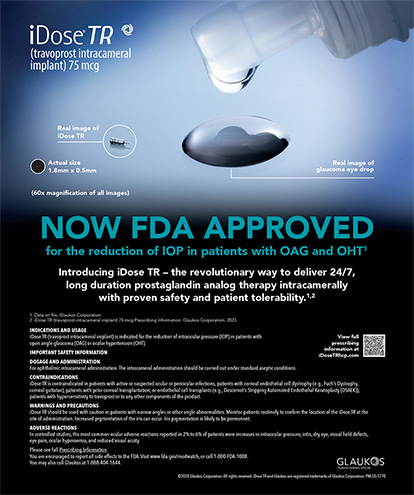

The COVID-19 pandemic has left many practices adrift, bobbing up and down at the mercy of the pandemic’s many waves of change. Some have been hit by harder and bigger waves, leaving them on the verge of drowning, whereas others have been mostly unaffected. As of this writing, our average client is operating at about 80% to 85% of their historical 2019 baselines, but there is wide variation among our client base, with some just now reopening and others operating at well over 100% of their 2019 baselines.
The luxury of time has allowed us to reflect on and analyze ophthalmology’s response to the pandemic. In doing so, we identified six variables that strongly influenced a practice’s ability to survive the pandemic (see Variables Influencing Practice Success During the COVID-19 Pandemic). An understanding of practice financials combined with greater capital access, boldness, and leadership have carried the most fortunate practices—typically those located farther away from hard-hit urban areas—through this pandemic’s effects quite briskly. These variables will continue to influence a practice’s success during the COVID-19 pandemic should there be a second wave or a future crisis.
VARIABLES INFLUENCING PRACTICE SUCCESS DURING THE COVID-19 PANDEMIC
Location
In our experience, rural practices in places off the grid, so to speak, such as Montana or Idaho, have been less affected by the current pandemic than urban practices. Certainly, this varies among clients, some of whom have both urban centers and rural satellite offices. There's a difference in patient perspectives on COVID-19. When patients, staff, and doctors alike are less frightened, business gets back to normal faster.
Patient Population
The practices that we have found to be the most resilient are those that treat catastrophic ocular diseases. Retina practices, for example, have largely done just fine. A typical retina practice among our clients bottomed out in April and May but still reported patient volumes at about 80% of historical levels in that same timeframe. Most of these practices (as this article goes to press) are now back or nearly back to 2019 patient volume baselines.
Boldness and Drive
If they've been bold, the doctors who are in control of their practices have been faster to dig out and restore prepandemic practice volume. These doctors set the tone and expectation in their companies that the pandemic would not unduly delay a return to old plans and patient volume.
Capital Access
Capital access allows a practice time to emerge slowly from the COVID-19 pandemic if a slow emergence is indicated. Practices with greater capital access and doctors with strong personal balance sheets can afford to move more slowly out of lockdown. This factor has been especially important in urban practices that shut down earlier and have had to take an incremental approach to reopening because of their location.
Capital access also buys older practitioners time. Doctors in their 30s or 40s may be able to be a little bolder in returning to a full volume of patients and resuming full personal exposure to patients and staff. Doctors in their 60s and 70s may get back to business more slowly. Many of our clients in that age group are returning to practice with limited schedules.
Leadership
Practices with strong lay and physician-owner leadership were able to respond, secure staff compliance, and make better decisions faster at the outset of this pandemic. The practices that were less organized or had fewer leadership capabilities have had a more challenging time responding in real time to the pandemic and an equally hard time coming out of lockdown. It's the practices with poor administrative and doctor leadership that are struggling the most today. Practices that lack leadership and capital access are in particular trouble.
Financial Volume and Metric Awareness
Without a stopwatch, track stars can't evaluate how fast they are running and set goals for improvement. Practice-owners who went into the pandemic with a clear, real-time understanding of their practices' financial and volumetric performance were able to assess how they were doing, gauge their trajectories through the pandemic, and plan for the future.
This article discusses five actions that you can take to help your practice emerge from this pandemic successfully and to position your practice for success in the future.
1. Write a Strategic Business Plan
Let’s consider two extreme examples. The first is a solo practitioner well into his 70s who plans to work for only 3 more years. His strategic plan might appropriately be to close the practice because it will be too difficult to spend the next year getting back up to full volume only to close the practice down in 1 to 2 years.
The other extreme is a large multigenerational, multispecialty practice that has a couple hundred families depending upon its future success. It’s important to think about the long-term future of this type of practice. The owners must ask themselves, “Is there something that we should be doing differently to be better prepared next time?” The longer that a practice is in business, the higher the odds are that it will experience something similar to this global pandemic again. (Our clients in Asia, where coronavirus illnesses have been more common, are more accustomed to responding to novel coronavirus outbreaks.)
Whatever your practice situation, it is important to write a strategic plan. Once it has been drafted, it should be revised annually. A strategic plan should have been in place before COVID-19 hit. If you have not drafted one yet, it’s important to write one whether your practice is large or small. A strategic plan will help you respond faster and cope better with similar challenges as they arise.
2. Refresh and Increase Capital Access
Dollars may be available from various sources, including active bank accounts, pledges from your practice’s owners to provide capital for the business if it’s in trouble, the recoverable portion of the accounts receivable, and bank lines of credit. Before COVID-19, we advised clients that all of those capital sources taken together should be no less than three times the practice’s monthly operating costs. So, we’d have said that, to keep the doors open and the staff paid, a practice with a $100,000 burn rate every month should have $300,000 in ready capital access.
Somewhat chastened by COVID-19, we currently advise owners to have at least five or six times their practice’s monthly burn rate readily accessible. For most practices, this necessitates keeping higher working reserves, potentially by distributing less capital to the owners each year for a while to build up those reserves. Practices must also negotiate a higher line of credit with a bank to ensure that five or six times their monthly operating costs are readily at hand.
3. Recalibrate Expenses
If you are going to reduce your volume of practice permanently—to account for social distancing or simply to lessen the workload—it’s important to decrease your practice’s expenses so that they stay in line. Operating expenses should not exceed $0.70 for every $1.00 of income. In the best-run practices, $0.50 to $0.60 of every dollar earned goes toward covering expenses each month.
4. Increase Patient Volume
If your practice is achieving 85% to 90% of its 2019 baselines and you’re feeling stuck on that plateau, dig deep and—within the bounds of safety and comfort—try to increase patient volume incrementally. The goal regardless of the pandemic is to improve profitability by increasing revenue. Seeing just three more patients per clinic day can increase a practice’s profit by $100,000 a year, so take a close look at your patient volume. If yours is still a shadow of its 2019 figures, work with your team to safely add a few patients per day.
5. Adjust Personal Financial Plans
Take a fresh look at your personal financial goals as a doctor. We all took a lot for granted up until 2019; we were emerging quite well from the Great Recession, and it looked as if the next few years of investments would treat us well. COVID-19 reset expectations for market volatility for many of our clients deciding how much longer they want or need to work, what they’ll need in retirement, and what their earning potential will be between now and then.
Make sure that you, like your practice, have capital reserves and financial resilience. Ensure that you have the savings rate and the flexible thrift to respond and thrive when future economic changes come sweeping through.
Conclusion
During the past several months, our average client practice has done much better than we might have expected based on the forecast in March when everyone was running for the hills. At that time, there were fears that the pandemic could deliver a mortal blow to many practices. Overall, we’ve seen instead that practices, staff, and providers are more resilient.
Even so, there’s good reason to learn from the lessons of the past year. For example, some practices saw that they could run with leaner staffing ratios. Take the time to analyze the year. Ask yourself, “What did we learn about our practice’s functioning during this time? What did we do well? What didn’t we do well? How can we be better prepared the next time?”
Your answers to questions such as these can help you to prepare for the next unforeseeable and significant economic downturn.




